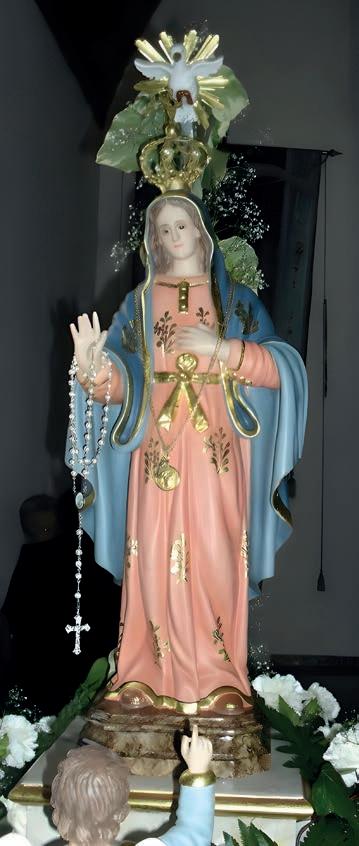
4 minute read
Warning
It is human nature to avoid thinking about our own death. Our Blessed Lady, however, would never leave us unprepared for such an important event. So, we should not be afraid. Depictions of Our Lady have evolved over the centuries, reflecting diverse artistic, cultural and theological influences, from early Christian iconography to late Renaissance art.
In the late seventeenth century, in the small Portuguese village of Serapicos, a chapel was dedicated to Our Lady of the Warning. The exact date the chapel was first constructed is unknown. The chapel's sanctuary features a large statue of Our Lady of the Warning, which is the first appearance of her in the form we recognise today. Our Lady is wearing a long pink dress with an outer blue mantle. Rosary beads hang from the fingers of her right hand, while a golden chain hangs from her left wrist. On her head is a crown around which are twelve stars.
In 1726, records show that the chapel was maintained by a group of devoted lay people who were enriched with many indulgences. For many years, the villagers of Serapicos have prayed to Our Lady to thank her for saving a distressed man, who, when returning home on a winter's day in an oxcart, was attacked by a pack of wolves. So overwhelmed by his anguish, he begged Our Lady to help him fend off the wolves. Almost immediately, the wolves retreated. Several devotees of the statue asked to borrow it for a visit to their home, but none was successful. The following accounts describe the statue resisting being moved. In 1840, a group of people wanted to borrow it for the funeral of a Mrs Pimparela. They hired a group of men to carry it to her home. The statue was so heavy that they only made it 300 metres from the chapel before they had to turn back. Another account indicates that the people of Sanceriz, a neighboring village, were authorised to bring the statue to their local church.

But a group of men could not dislodge it because of its weight and the attempt was abandoned.
In 1890, the chapel had developed serious structural defects and as a result, a new and larger one was constructed in the same location it stands today.
People worldwide who carry the medal of Our Lady of the Warning and pray to her fervently believe that she will warn them of their death. Many devotees of Our Lady of the Warning have obtained a tremendous number of graces, including a deaf child whose hearing was restored. However, the most frequently reported grace was that of people being warned of their impending demise.
A priest from the region has described two reports, which occurred in the 1980s.
In March 1986, Mrs Rufina Baptista, an 84-year-old devotee of the medal, became ill. She notified her children living in France to return so that they could be with her before she passed away. When they arrived, she said: ‘I was waiting for you. Now I can go. I’ll go tomorrow as Our Lady told me.’ She passed away on March 18 of that year.
The other report concerned a woman who had been on a pilgrimage to the chapel in 1988. Three days before her husband's passing, her husband asked her to fetch a priest to administer the Last Rites, as he was certain he was about to die, she said. He always wore the medal and three days later he died. Shortly after, the fifteen-year-old son of this woman became seriously ill. Despite his severe condition, his mother remained confident he would recover. One day, he called her and said: ‘Mama, please fetch the priest. Our Lady has advised me that I’ll die in three days.’ When asked how he was so advised, he said: ‘I cannot say how, as it is a secret. But I was advised.’ He, like his father, was dead within three days.
The annals of devotion to Our Lady do not report anyone panicking or becoming desperate after being forewarned about their death. Instead, an amazing sense of calmness descends on them as well as a conformity to God’s will, which is the emblem of Our Lady. Although death may be a lonely and painful experience, in fact it isn’t. Our Lady will be with us when we die and will ease us into it. We must trust that God, the embodiment of wisdom, has determined the appropriate time for us to give an account of ourselves to Him.
As Our Lady says, ‘Do not lose heart, I will never forsake you.’










